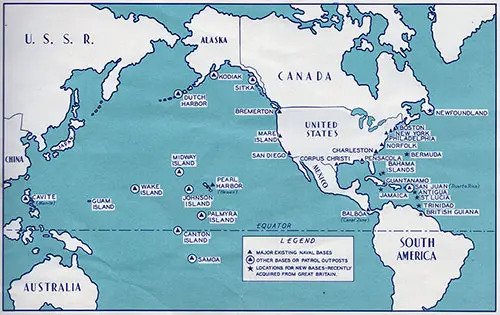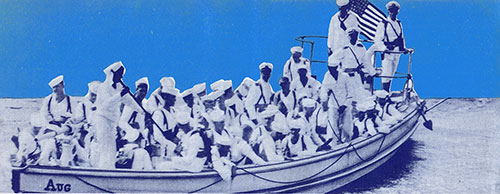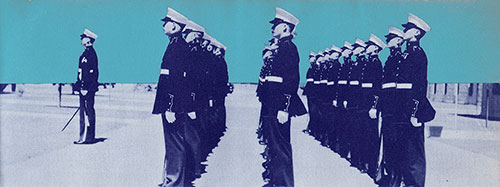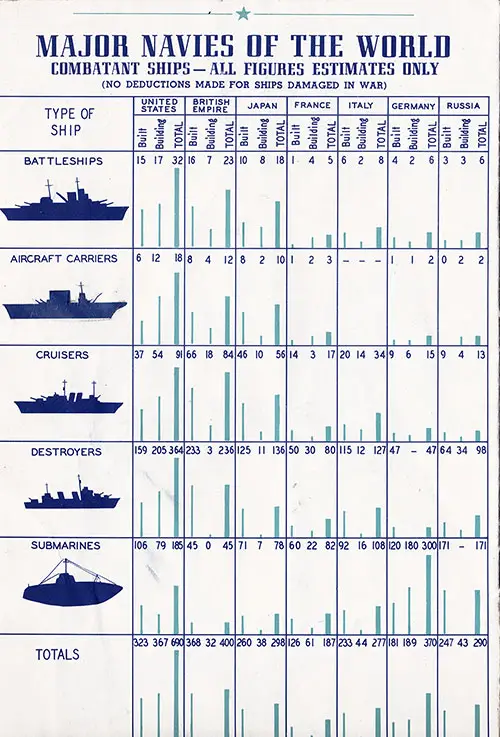The Base Force - Our Navy in WW2 - 1945

Map of Major Existing Naval Bases, Other Bases, or Patrol Outposts. It Includes Locations for New Bases -- Recently Acquired from Great Britain. Our Navy, 1945. | GGA Image ID # 1d657dd1e1
BASES
Naval power does not lie in ships and planes alone, but in a combination of Men, Ships and Planes, and Bases.
A man-of-war requires innumerable items which can be transported by herself in but limited quantities, such as fuel to operate her—food for the crew—ammunition for her guns—and many other consumable supplies necessary for upkeep and maintenance.
Eventually, too, the ship will require docking for repairs and reconditioning. The closer our fleet can be to bases of supply, no matter how far from home, the more efficient will be the results obtained.
Conveniently located and properly equipped bases automatically multiply the numbers and power of ships that can be kept in action, because ships will not need to travel great distances to home ports for refueling, repairs or for supplies.
Today, we are fortunate in our ring of Naval Bases. The accompanying map (above) shows the major bases, patrol outposts and, particularly, sites of the eight new bases in the Atlantic and Caribbean areas recently acquired from Great Britain.
These latter bases, extending from Newfoundland in the north to British Guiana in the south, enable us to meet an approaching enemy a thousand miles farther eastward than we could before these sites were acquired. Recently through an agreement with the government of Denmark, we have acquired rights to establish a base, or patrol outpost, on the tip of Greenland.
Hawaii may truly be called the Gibraltar of the Pacific. It provides a large berthing space for the fleet at Pearl Harbor and is relatively well protected. Patrol outposts have been established on other islands in the Pacific, as shown by the map.
Bases in Alaska and at Dutch Harbor in the Aleutian Islands are being greatly strengthened.
Adequate Bases are located along both our coast lines to service our Atlantic and Pacific fleets. Should the Panama Canal be destroyed, thus preventing movement of our fleets from one ocean to the other, our bases are so situated and equipped that each fleet could operate successfully as a separate unit.
Truly, Bases are as vital to our National Defense as are the actual fighting ships of our Fleet.
MEN OF THE NAVY

Men of the Navy. Our Navy, 1945. | GGA Image ID # 1d65ee9256
As a result of the expanding building program the question of personnel has become exceedingly important. The thought of a "Two-Ocean Fleet," consisting of great numbers of modem ships and planes, together with adequate bases, affords a feeling of security.
Yet these ships and planes would not be effective without highly-trained personnel in tactics, gunnery, engineering, communications and allied specialties.
To man our future navy of some 690 combatant vessels, numerous auxiliaries, and 15,000 or more planes, we will need, afloat and ashore, a total of approximately 35,500 officers and 461,000 enlisted men.
The basic source of regular Navy officer personnel is the Naval Academy at Annapolis, Maryland. The Academy does not have facilities for training all the officers needed for our new Navy. Since 1926 prominent Universities have co-operated in the establishment of Naval Reserve Officer Training Corps and today there are about 3,000 Naval R. O. T. C. students in 19 universities, as well as many graduates, now in the Naval Reserve.
A large percentage of the officers in the Aviation branch are graduates of Annapolis. The remainder are reserve officers who pass through the Navy's training school at Pensacola, Florida— or the newly established schools at Corpus Christi, Texas, Jacksonville, or Miami. Florida.
We now have in the Navy over 200,000 enlisted men and new men are being added at the rate of 5,000 to 6,500 per month. The training of enlisted men is a complicated process, as few recruits have any experience in the work they must perform.
There are approximately 130 different ratings in the Navy—each rating a distinctive class representing different kinds and degrees of training.
If not forced by emergency to take other measures, the Navy prefers to fill existing ships to complement with regular recruits before undertaking the induction of trainees under a compulsory training law.
THE MARINE CORPS

The United States Marine Corps. Our Navy, 1945. | GGA Image ID # 1d65f6db17
The Marine Corps is an integral part of the Navy. The corps consists of approximately 1,500 officers and 38,600 enlisted men.
These men are known as "Soldiers of the Sea." The authorized strength of the regular Marine Corps is 2,500 officers and 46,400 enlisted men. These figures may be augmented in emergency by calling to active duty about 7,000 reservists.
Marine detachments form a part of the complement in all our Battleships, Aircraft Carriers and Cruisers. These detachments furnish gun crews for the secondary batteries, the antiaircraft guns, and the machine guns. They also form the nucleus for the landing force organization in the ships.
For the U. S. Fleet to operate effectively and to maintain itself far from home shores, the rapid seizure and effective defense of advance bases from which the Navy may operate is essential to effective progress of Fleet operations.
The organization maintained for this duty by the Navy is called the Fleet Marine Force and is an integral part of the United States Fleet.
The Fleet Marine Force is composed of infantry, artillery (including anti-aircraft artillery) aviation, tanks, signal, engineering, and chemical troops.
The Navy afloat cannot operate without a vast array of shore establishments. Though the duty of the Marine Corps personnel serving in this vast outlay of naval shore establishments is primarily guard duty, at the same time every Marine so serving is kept constantly trained for war service, both afloat and ashore.
The Marine Corps obtains its officers from graduates of the United States Naval Academy, from graduates of leading institutions of learning in all parts of the country through competitive selection and appointment, from the Marine Corps Reserve, and from outstanding enlisted men who after competitive selection, pass an examination showing academic training equivalent to a college curriculum.

Combatant Ships of the Major Navies of the World. Estimates for the United States, UK, Japan, France, Italy, Germany, and Russia. Our Navy, 1945. | GGA Image ID # 1d662d4e02
